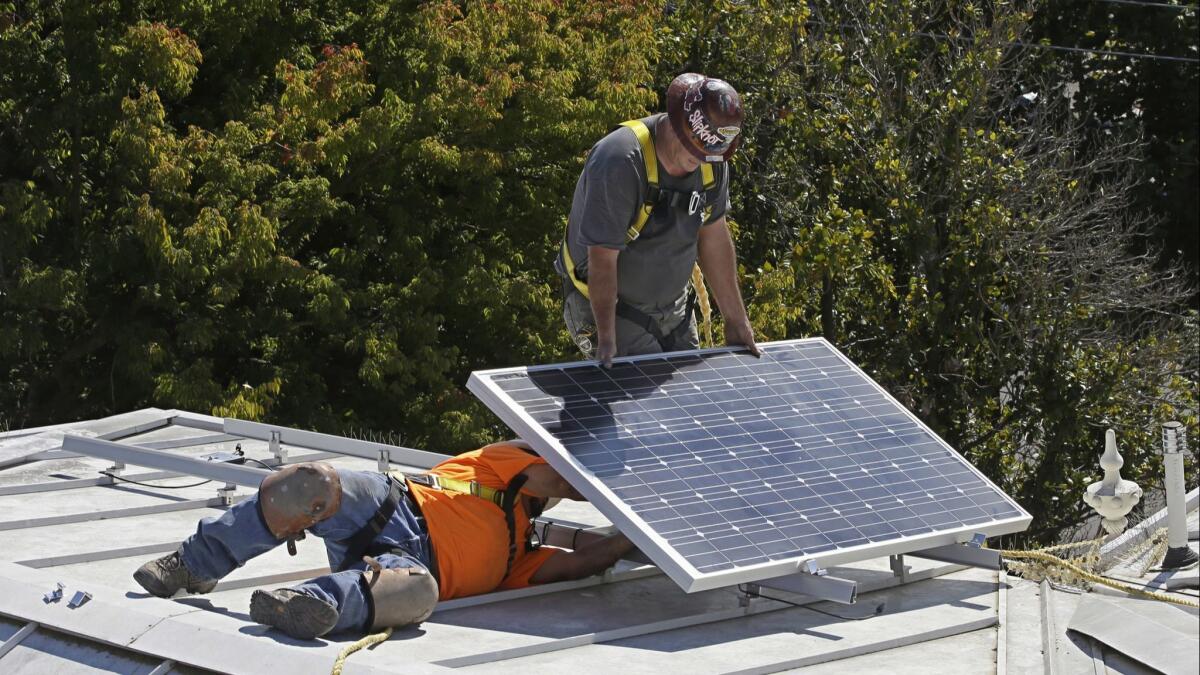Editorial: Of course California should require solar panels on new homes

- Share via
Starting in 2020, California will be the first state in the nation to require newly constructed homes and low-rise apartment buildings to have solar panels to generate electricity. This mandate, adopted this week by the California Energy Commission, may be the simplest, most logical policy yet to help wean the Golden State off fossil fuels and reduce greenhouse gas emissions.
The benefits of solar power are well established. Photovoltaics harness the sun to create electricity, reducing the need for dirtier forms of energy. And residents generate their own power, cutting their utility bills.
The energy commission’s new building standards, which require both solar panels and upgraded insulation, air filters and other efficiency measures, are expected to raise the cost of a new home by $9,500. That’s about half the cost of installing solar systems on existing homes (although tax breaks and other financial incentives can lower the bill). And homes built to the new standards are expected to use 50% as much energy as homes built in 2016 without solar panels.
These requirements — assuming they’re ratified as expected by the California Building Standards Commission — will reduce greenhouse gas emissions by 7,000 metric tons over three years, which is the equivalent of taking 115,000 gas-powered cars off the road. That’s important because buildings account for 25% of the state’s greenhouse gas emissions. The emissions come from burning natural gas in furnaces and water heaters, and from the power plants that generate the electricity used by appliances and air conditioners. Lawmakers have committed to doubling the energy efficiency of all buildings by 2030. It’s far easier and cheaper to build no- or low-emission buildings from the start than to retrofit structures later.
Yes, the new standards will increase the cost to build homes and apartment complexes. That’s a concern in California, which is in the midst of a housing crisis because it failed for years to build enough homes to keep up with population demand. However, energy-efficiency investments save money over time. The energy commission estimated the new standards will add $40 per month to the average new home mortgage payment, but save $80 per month on heating, cooling and lighting.
The fact is it’s going to be expensive to decarbonize California. There is an upfront cost to reducing the state’s dependence on fossil fuels, whether investing in renewable power sources or building the infrastructure to support electric vehicles and equipment.
The energy commission estimated the new standards will add $40 per month to the average new home mortgage payment, but save $80 per month on utilities.
But there is a long-term payoff for those investments. The air will be cleaner and healthier for Californians. The state is spurring innovation and job creation in the clean-energy sector. (California is ranked first in the nation for solar industry jobs at 86,000 — seven times more than the second-ranked state.) And California, which recently climbed a notch to become the world’s fifth largest economy, is demonstrating that ambitious policies to cut greenhouse gas emissions do not stifle economic growth.
Granted, the state shouldn’t wed itself to one particular technology when it comes to reducing residential emissions. Specific technology mandates can freeze innovation at the cost of better solutions down the road. But the energy commission is leaving developers flexibility to explore battery-storage options and other alternatives, and it revisits energy-efficiency mandates every three years. That’s sensible.
At the moment, there’s simply no better way to reduce the power demand and greenhouse gas emissions from new residential developments than combining solar power with more energy-efficient designs. The long-term savings, both to homeowners and to the environment, are well worth the up-front cost.
Follow the Opinion section on Twitter @latimesopinion and Facebook
More to Read
A cure for the common opinion
Get thought-provoking perspectives with our weekly newsletter.
You may occasionally receive promotional content from the Los Angeles Times.






